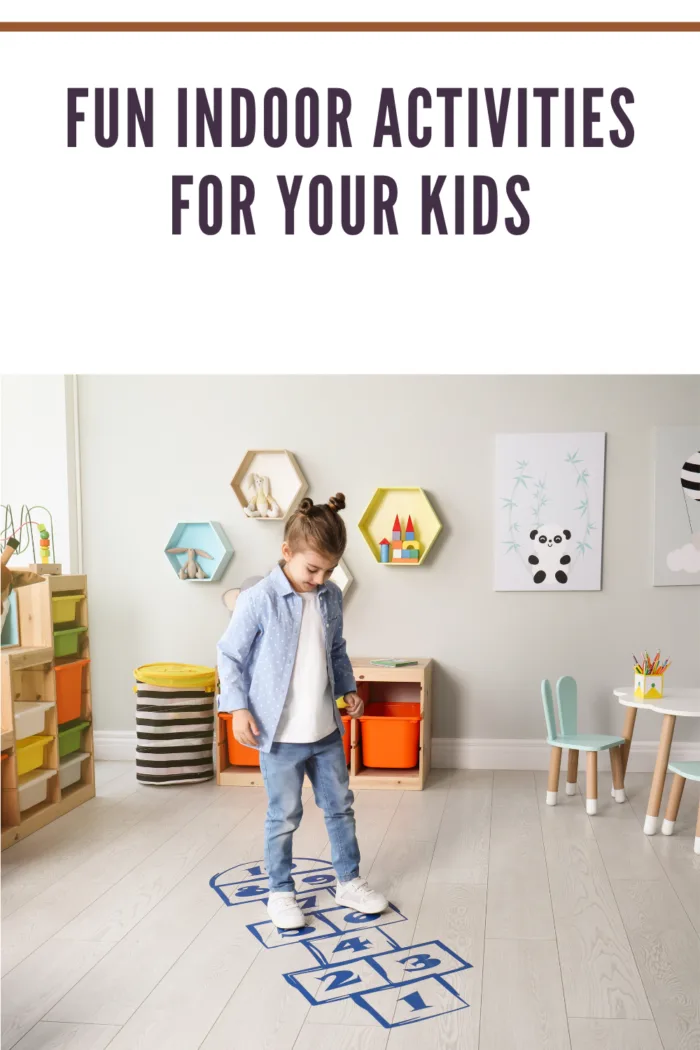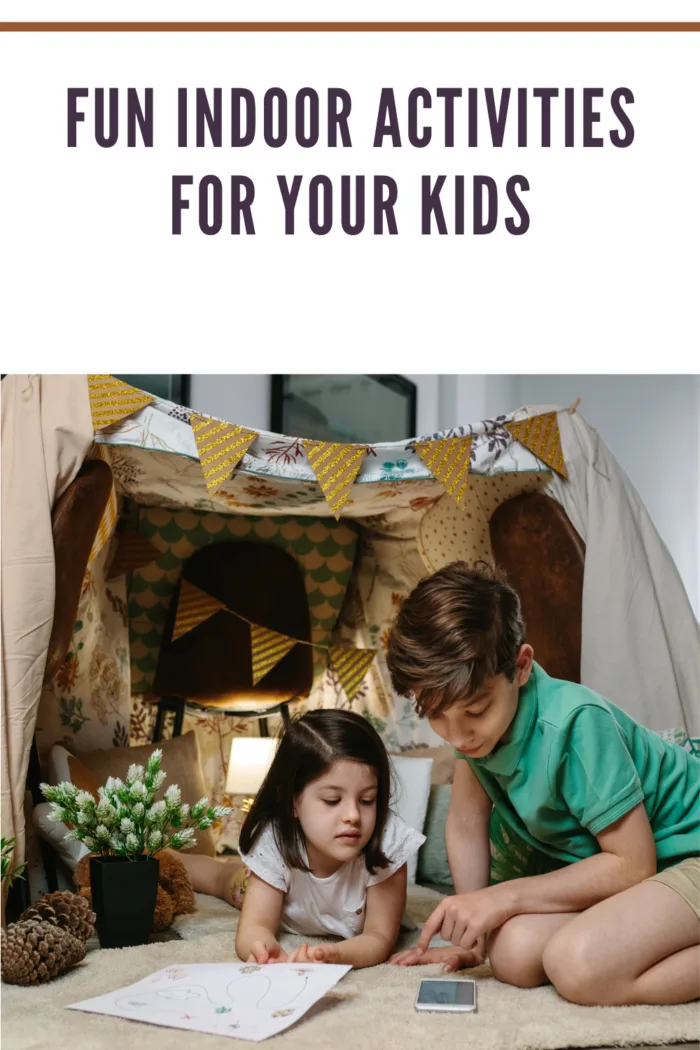Find more ways to occupy the minds of your little here with these indoor activities for kids. Kids are great; they are so full of energy and curiosity about the world. They are so energetic that most adults can’t keep up with them. So what to do if you can’t go outside to play with them for whatever reason? Some parents resort to television and the internet to pacify their children. However, this is not the best way to build their personalities, and especially not the way to help them healthily build their bodies. These need to involve physical activities which help the proper development of a child and be a lot of fun.

Great Indoor Activities for Your Kids
Freeze
This game is particularly fun for younger kids. Play their favorite music and have them dance. At a certain point, pause the music. The rule of the game is that your child (or children) need to freeze in whatever position they were in when the music stopped. The game helps improve their balance and spatial awareness. This game is more fun when more children are involved, like at a birthday party or some similar event, but nothing stops you from playing the game with only one child.
How to Play Freeze:
“Freeze” is a simple game that involves players freezing or remaining still when a certain action or condition is met.
Here’s how to play:
- Gather a group of players. The game works best with three or more participants.
- Choose a “freeze master” or a leader who will initiate the actions or conditions that will cause players to freeze.
- The freeze master starts the game by giving a command or setting a condition. For example, they might say, “Freeze when I clap my hands” or “Freeze when I say a specific word.”
- Once the command or condition is given, all players start moving or dancing around.
- The freeze master will then try to catch players off guard by suddenly clapping their hands or saying the designated word. When players hear or see the signal, they must immediately freeze in their current position.
- Players who fail to freeze in time or continue moving after the freeze signal are out of the round. They can either sit out for the remainder of the game or become freeze masters themselves and take turns initiating the commands or conditions.
- The game continues with the freeze master introducing new signals or commands, and the remaining players freezing accordingly.
- The last player remaining, who has successfully frozen each time, becomes the winner of the round.
- You can play multiple rounds, allowing different players to be freeze masters and keeping track of points or simply playing for fun.
Remember to establish some basic rules and guidelines beforehand, such as not touching or physically interfering with other players during the freezing phase, to ensure everyone has a safe and enjoyable experience.
“Freeze” is a great indoor activity for kids for several reasons:
- Active engagement: “Freeze” encourages kids to move and be physically active. It provides an opportunity for them to dance, jump, and twirl around, which is beneficial for their physical health and development.
- Social interaction: The game involves multiple participants, allowing kids to interact with their peers. They can laugh, communicate, and have fun together while playing “Freeze,” fostering social bonds and teamwork.
- Cognitive development: “Freeze” also challenges children cognitively. They need to listen attentively to the freeze master’s commands or conditions, and react quickly by freezing in response to the signals. This promotes listening skills, enhances concentration, and improves reaction times.
- Creativity and imagination: While moving around, kids can express their creativity and imagination by incorporating different dance moves or gestures. They can invent their own poses when freezing, allowing for self-expression and exploration.
- Indoor-friendly: “Freeze” can be played indoors, making it suitable for times when outdoor play is not feasible due to weather conditions or space limitations. It provides an entertaining and energetic option for kids to burn off excess energy within the confines of a room or designated play area.
- Inclusive and adaptable: The game can be adjusted to accommodate children of different ages, abilities, and interests. The freeze master can modify the commands or conditions based on the participants’ capabilities, ensuring that everyone can actively participate and enjoy the game.
- Simple and accessible: “Freeze” is easy to learn and doesn’t require any specialized equipment. It can be played spontaneously with minimal setup or preparation, making it a convenient choice for indoor activities.
Overall, “Freeze” combines physical activity, social interaction, cognitive stimulation, and creativity, making it an engaging and entertaining indoor activity for kids.
Hopscotch
Another game designed to test your children’s balance, but also hand-eye coordination is hopscotch. Even though it is traditionally associated with the outdoors and the playground, it can easily be adapted to your living room. Instead of drawing it on the ground with chalk, you can draw the hopscotch lines with duct tape on the floor. It will not damage your floor, and it will make sure that the lines don’t move. All you need now is a token. It can be a coin, a Lego piece, or any other small item you can think of.
Hopscotch is a traditional outdoor game, that can be adapted for indoors, played with a patterned grid drawn on the ground and a small object to toss.
Here’s how to play:
- Draw the hopscotch grid: Find a flat, clear surface. Use tape to draw a grid on the ground. The grid consists of a series of numbered squares or rectangles arranged in a linear or snake-like pattern. The most common hopscotch design features ten squares, but you can adjust the size and complexity based on the players’ skill levels.
- Understand the numbered squares: Each square in the grid is assigned a number, usually from 1 to 10. The first square, where players start, is labeled as number 1. The subsequent squares are numbered sequentially until the last one.
- Determine the throwing line: Establish a line a short distance away from the hopscotch grid. This line is called the “throwing line” or “tossing line.” It should be a comfortable distance for players to throw an object into the hopscotch grid.
- Choose a marker: Find a small object such as a stone, pebble, beanbag, or coin to use as a marker. This will be tossed onto the numbered squares as part of the game.
- Start the game: The first player stands behind the throwing line and throws the marker onto square number 1 in the hopscotch grid. The marker must land within the boundaries of the square without touching any of the lines.
- Hop through the grid: The player begins the game by hopping on one foot into square number 1. They must skip over the square containing the marker.
- Navigate the grid: Players continue hopping through the hopscotch grid, moving forward one square at a time. When they reach squares with two adjacent spaces (usually squares 4 and 5 or 7 and 8), they must land with one foot in each square simultaneously.
- Reach the end and turn back: When a player reaches the end of the hopscotch grid (e.g., square number 10), they must turn around without stepping on the border lines or landing on the square containing the marker. They then hop back through the grid in the reverse order.
- Pick up the marker: As players hop back, they must bend down and pick up the marker from the square it landed on, while maintaining their balance and only using one foot.
- Complete the game: The player continues hopping through the hopscotch grid, returning to the starting point. The game concludes when the player successfully completes the entire grid without stepping on the lines, missing a square, or losing their balance.
- Pass the turn: After the first player finishes their turn, the next player takes a turn by throwing the marker onto square number 2. The game proceeds in this manner, with players progressing through the grid and taking turns throwing the marker until everyone has had a chance to play.
You can modify the rules or add variations to make hopscotch more challenging or suited to specific preferences. It’s a fun and active game that helps develop balance, coordination, and counting skills in an outdoor setting.
Hopscotch can also be adapted as an indoor game, making it a great activity for kids in various settings.

Here are some reasons why hopscotch works well as an indoor game:
- Physical activity: Hopscotch provides an opportunity for kids to engage in physical activity even when they’re indoors. It involves hopping, balancing, and movement, which are beneficial for their gross motor skills development.
- Energy outlet: Indoor environments often restrict the space available for active play. Hopscotch offers a structured and contained way for kids to release their energy, burn off excess calories, and engage in movement-based play within a confined area.
- Balance and coordination: Hopping and jumping in hopscotch require balance and coordination. By playing indoors, kids can practice and enhance these skills while having fun.
- Cognitive development: Hopscotch can be a mentally stimulating game for kids. They need to follow the numbered sequence, remember the rules, and strategize their movements to avoid stepping on the lines or missing squares. This helps improve their memory, concentration, and problem-solving abilities.
- Indoor-friendly: Unlike some other physical games, hopscotch can be adapted to indoor spaces without requiring any specialized equipment. You can use masking tape or colored tape to create the grid on the floor, or even use a hopscotch mat or carpet with the design already printed on it.
- Social interaction: Hopscotch can be played individually or in groups, providing opportunities for social interaction and cooperation among kids. They can take turns, compete with each other, or cheer on their friends, fostering social bonds and communication skills.
- Educational benefits: Hopscotch offers opportunities for learning and skill development. Kids can practice counting as they move through the numbered squares, reinforce number recognition, and improve their ability to follow the rules and instructions.
- Creativity and imagination: Indoors, kids can add their own creative elements to the game. They can decorate the squares with colors, shapes, or patterns, or even create themed hopscotch grids related to their interests or favorite characters.
- Play anytime: Weather conditions or time constraints may limit outdoor play, but hopscotch can be enjoyed indoors regardless of the weather or time of day. It can be a go-to activity for active play during rainy days, winter months, or when outdoor play is not possible.
Remember to clear any fragile or valuable items from the play area to prevent accidents or damage. Indoor hopscotch provides an engaging, active, and mentally stimulating experience for kids within the comfort and safety of an indoor environment.

Treasure Hunt
You have probably played this game outdoors before. An item or a group of items is hidden somewhere, and you are given some clues which lead you to other clues that should eventually lead you to the treasure. The idea is the same, except you play it indoors. This game can help develop your kids’ critical thinking and reasoning, as well as keep them active without it becoming destructive (like jumping on the bed or climbing the shelves).
Playing a treasure hunt involves hiding objects or clues for participants to find, leading them to a final “treasure” or goal.
Here’s a step-by-step guide on how to play a basic treasure hunt:
- Choose a location: Decide where you want the treasure hunt to take place. It can be indoors, such as within your house or a specific room, or outdoors in a park, garden, or backyard. Consider the size of the area and any potential hiding spots.
- Determine the theme and goal: Decide on a theme for the treasure hunt, which can be anything from pirates to superheroes or a simple scavenger hunt. Determine the ultimate goal or treasure that participants will seek.
- Prepare clues or riddles: Create a series of clues or riddles that will guide participants from one location to the next. Each clue should lead them closer to the final treasure. The complexity of the clues can be adjusted based on the age and abilities of the participants.
- Hide the clues: Place the clues in their respective hiding spots, making sure they are not too easy or too difficult to find. You can place them inside drawers, under objects, taped to walls, or buried outdoors—get creative with the hiding spots, but keep them safe and accessible.
- Start the treasure hunt: Gather the participants and explain the rules of the game. Provide them with the first clue to kick-start the treasure hunt. Alternatively, you can hand out the first clue in an envelope or attach it to a balloon, adding to the excitement.
- Follow the clues: Participants work together or individually to solve each clue and find the next location. Once they find a clue, they read it aloud or share it with the group, allowing everyone to brainstorm and collaborate on the next steps.
- Reach the final treasure: The final clue should lead the participants to the ultimate treasure or goal. It could be a hidden box, a hidden item, or a surprise treat. Make it exciting and rewarding to motivate the participants throughout the treasure hunt.
- Celebrate and conclude: Once the treasure is discovered, celebrate the participants’ success. Congratulate them on completing the treasure hunt and share any rewards or treats. You can also take photos to commemorate the experience.
Remember to consider the age range and interests of the participants when planning the treasure hunt. You can customize the difficulty level, incorporate additional challenges or puzzles, or adapt the game to suit different themes or occasions. The main objective is to create an engaging and enjoyable experience that encourages teamwork, problem-solving, and exploration.

Treasure hunts can be a fantastic indoor activity for kids for several reasons:
- Active engagement: Treasure hunts get kids up and moving. They actively search for clues, explore different areas of the house, and engage in physical activity as they navigate through the hunt. It helps promote an active lifestyle and breaks the monotony of sedentary indoor activities.
- Cognitive development: Treasure hunts stimulate critical thinking and problem-solving skills. Kids need to decipher clues, analyze information, and use logic to progress through the hunt. It enhances their cognitive abilities, such as reasoning, memory, and attention to detail.
- Creativity and imagination: Treasure hunts spark creativity and imagination. Kids can immerse themselves in the theme or story of the hunt, imagining they are on a pirate adventure, a detective mission, or any other exciting scenario. It encourages imaginative play and storytelling.
- Teamwork and collaboration: Treasure hunts can be played individually or in teams. When played with others, kids learn to cooperate, communicate, and work together to solve clues and achieve a common goal. It fosters teamwork and social interaction and enhances interpersonal skills.
- Indoor-friendly: Treasure hunts are adaptable to indoor spaces. They can be customized to fit any size of the house, whether it’s a small apartment or a larger home. You can hide clues in different rooms, behind furniture, in drawers, or even create hiding spots using props or decorations. It’s a versatile activity that can be tailored to suit the available space.
- Interactive and engaging: Treasure hunts are highly interactive and engaging. The element of surprise, the thrill of discovery, and the anticipation of finding the treasure create excitement and motivation. It keeps kids entertained and provides a break from passive screen time.
- Learning opportunities: Treasure hunts offer opportunities for learning and knowledge acquisition. You can incorporate educational elements into the clues or theme, such as math problems, trivia questions, or historical facts. It makes learning fun and memorable.
- Indoor entertainment: Indoor activities can be limited, especially during inclement weather or when kids need to stay indoors for extended periods. Treasure hunts provide an entertaining and enjoyable indoor activity that can be set up relatively easily with minimal resources.
- Customizable and adaptable: Treasure hunts can be customized to suit different ages, interests, and skill levels. You can adjust the complexity of the clues, the difficulty of the challenges, or even introduce additional puzzles or riddles. It makes the activity inclusive and suitable for a wide range of children.
Overall, treasure hunts offer a combination of physical activity, cognitive stimulation, creativity, and social interaction. They provide a fun and engaging indoor experience that keeps kids entertained, promotes learning, and encourages active participation.

Indoor Amusement Parks
Playing indoors at your own home can be a lot of fun, but it requires a lot of creativity, compromises, and improvisation. On the other hand, there are places specifically designed to keep your kids physically active and engaged. These indoor amusement parks boast a variety of activities, such as trampoline parks, obstacle courses, slides, climbing walls, and more. The best part is that it is all very safe and monitored by professionals, so you can relax.
There are several indoor amusement parks around the world that offer a wide range of exciting activities for kids.
Here are a few examples:
- KidZania: KidZania is an international chain of indoor amusement parks designed for children to experience different professions and roles in a realistic, interactive environment. Kids can try their hand at various jobs, such as being a doctor, firefighter, chef, or pilot, and earn KidZania currency while learning valuable life skills.
- LEGOLAND Discovery Center: LEGOLAND Discovery Centers are indoor amusement parks dedicated to LEGO-themed fun. They feature interactive LEGO attractions, play zones, 4D cinema experiences, LEGO building activities, and even miniature LEGO city displays. Kids can explore their creativity, build with LEGO bricks, and enjoy themed rides and attractions.
- Crayola Experience: Crayola Experience is an indoor amusement park that celebrates creativity and imagination through various interactive activities centered around Crayola products. Kids can engage in arts and crafts, create their own colorful masterpieces, participate in hands-on experiences, and enjoy themed attractions like the Crayon Factory or Doodle in the Dark.
- Nickelodeon Universe: Nickelodeon Universe is an indoor theme park located in the Mall of America in Minnesota, USA. It offers a variety of rides, roller coasters, and attractions featuring beloved Nickelodeon characters like SpongeBob SquarePants, Teenage Mutant Ninja Turtles, and Dora the Explorer. Kids can enjoy thrilling rides, meet their favorite characters, and immerse themselves in the world of Nickelodeon.
- Indoor Water Parks: Many indoor amusement parks include water park sections, providing a year-round aquatic adventure for kids. Examples include Kalahari Resorts, Great Wolf Lodge, and Atlantis Water Park Hotel & Suites. These indoor water parks feature slides, wave pools, lazy rivers, and water play areas designed specifically for kids.
- Trampoline Parks: Trampoline parks are indoor amusement parks filled with interconnected trampolines, foam pits, and other bouncing attractions. They offer a fun and active experience for kids, allowing them to jump, flip, and bounce to their heart’s content. Examples include Sky Zone, Altitude Trampoline Park, and Bounce.
It’s important to note that the availability and specific locations of these indoor amusement parks may vary based on your geographical location. It’s always recommended to check their websites or local directories for accurate and up-to-date information regarding activities, safety guidelines, and age restrictions before planning a visit.
Building Forts
A longtime tradition, indoor building forts is easy and always fun. Whether you choose to build your own from cardboard boxes or pillows, this is a fun activity that takes some energy and creativity. The best part of building a fort is that the fun doesn’t stop after the fort is built. Some would argue that fun is just ready to start then. You can use the fort to play a myriad of other games like Simon Says or Follow the Leader. Or you can have a pillow fight for control of the fort.
Building an indoor fort can be a fun and creative activity for kids.
Here’s a step-by-step guide on how to build one:
- Choose a location: Find a suitable space in your home where you can build the fort. It could be a living room, bedroom, or any area with enough open space to accommodate the fort.
- Gather materials: Collect the necessary materials for building the fort. You’ll need items such as blankets, sheets, pillows, chairs, clothespins, rubber bands, and/or tape.
- Create a base: Start by selecting a sturdy piece of furniture to serve as the base or anchor for your fort, such as a table, couch, or chairs. Position the furniture in a way that allows you to drape blankets or sheets over it, creating a structure.
- Secure the blankets or sheets: Drape the blankets or sheets over the furniture to form the walls and roof of the fort. Ensure that the fabric hangs down enough to create an enclosed space. Use clothespins, rubber bands, or tape to secure the fabric to the furniture, walls, or other supports.
- Add extra support: If needed, use additional chairs, pillows, or cushions to provide extra support or create partitions within the fort. This can help define different areas or rooms inside the fort.
- Create entrances and windows: Use openings or leave gaps in the fabric to create entrances and windows for easy access and ventilation. You can fold back sections of the fabric and secure them with clips or ties to create openings.
- Decorate and personalize: Once the basic structure is complete, let your creativity shine! Decorate the fort with additional blankets, string lights, stuffed animals, or artwork. Make it cozy and inviting by adding pillows, cushions, or rugs inside.
- Add activities or features: Enhance the fort by incorporating activities or features. You can bring in board games, books, flashlights, or even set up a small projector for a movie night.
- Enjoy the fort: Once the fort is built, it’s time to enjoy it! Crawl inside, read a book, play games, or have a picnic. Encourage imaginative play and create lasting memories.
Remember to ensure the fort is stable and safe. Avoid using heavy objects or sharp edges that could cause accidents. Additionally, adult supervision may be required, especially for younger children.
Building an indoor fort allows kids to use their imagination, provides a cozy hideaway, and offers a fun space for play and relaxation.

Building a fort is a fun indoor activity for kids for several reasons:
- Creativity and imagination: Building a fort allows kids to tap into their creativity and imagination. They can envision and design their own unique structure, creating a space that reflects their imagination and personal style. It encourages imaginative play and storytelling.
- Hands-on engagement: Building a fort involves hands-on engagement and problem-solving. Kids need to figure out how to secure the blankets or sheets, find suitable furniture or supports, and arrange the space effectively. It promotes critical thinking, spatial awareness, and manual dexterity.
- Personalization and ownership: Kids have the opportunity to take ownership of their fort. They can choose the materials, colors, and decorations, making it their own special space. It fosters a sense of pride, accomplishment, and independence.
- Cozy and private space: Forts provide a cozy and private space for kids to retreat and relax. It offers a sense of comfort and security, creating a personal sanctuary within the home. Kids can read books, play with toys, or simply unwind in their own little hideaway.
- Social interaction: Building a fort can also be a social activity. Kids can collaborate with siblings, friends, or family members to create a larger fort or build separate structures nearby. It encourages teamwork, communication, and cooperation.
- Escape from routine: Fort-building provides a break from everyday routines and screens. It offers a screen-free, imaginative play option that engages kids in a different way. It’s a chance to disconnect from technology and immerse themselves in a world of their own creation.
- Sense of adventure: Building a fort creates a sense of adventure and exploration. Kids can transform their living space into an exciting fort, castle, spaceship, or secret hideout. It sparks their curiosity and invites them to embark on imaginative journeys.
- Safe and controlled environment: Forts provide a safe and controlled environment for kids to play. It’s a contained space within the home where parents or caregivers can easily monitor and supervise their activities. It offers a balance between free play and a controlled play area.
- Memories and bonding: Building forts can create lasting memories and bonding experiences. Kids can involve parents or siblings in the process, working together to construct the fort. It becomes a shared experience that strengthens relationships and creates cherished memories.
Overall, building a fort combines creativity, playfulness, and a sense of personal space. It offers a fun and engaging indoor activity that encourages imagination, problem-solving, and social interaction, while also providing a cozy retreat for kids to enjoy.
Final Thoughts
Children have imagination and energy levels, which are hard to match when we are adults. That’s why it is important to keep them engaged and active as much as possible.
Building forts and engaging in indoor activities like treasure hunts, hopscotch, or freeze can provide children with opportunities for creativity, physical activity, cognitive development, and social interaction. These activities offer a break from screen time and promote imaginative play, problem-solving, and teamwork. Whether it’s building a fort with blankets and furniture, searching for hidden treasures, jumping through a hopscotch grid, or playing a fun freeze dance game, these indoor activities can be enjoyable, educational, and memorable for children. They foster a sense of adventure, encourage active engagement, and provide a safe and controlled environment for kids to have fun and learn. So, go ahead and encourage your child’s participation in these activities to create enjoyable and meaningful experiences.

